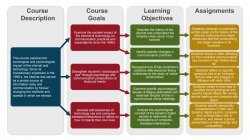Our team of instructional designers are available to collaborate with you on many aspects of designing your course(s). We are committed to learning from recent trends in learning science while leveraging the latest instructional technologies to support student learning and engagement. Some aspects of the course design process can take time to develop so it is best to start the process a semester before the course is going to be offered. The better designed the course is in advance, the more time you will be able to devote to facilitating the course.
Course design frameworks establish consistency in design while providing a model to follow throughout development and while teaching, enabling the integration of pedagogical best practices throughout each element of your course. In short, course design frameworks make your course the best it can be, enhance the student experience, and streamline the teaching experience for faculty.
Backwards Design: Designing With Goals in Mind
A student’s learning journey in your course concludes with their achievement of goals defined by you at the start of the semester. What concepts should be mastered, and how do we facilitate that mastery? The path to achieving those goals typically entails students’ active engagement with course materials, activities, discussions, assessments and much more.
The backwards course design model helps you facilitate your students’ learning journey by planning every aspect of your course around your course goals. The lectures you plan, the activities and assessments you design, and the way you organize your content should be inspired by (and align with) these learning goals to help students achieve them.
Wiggins and McTighe’s Understanding by Design (UbD) framework follows a “backwards” design approach. They recommend you start by defining your course goals and learning outcomes (LOs). You then determine learning assessments. What evidence is needed to confirm students met LOs? Lastly, you design learning activities. How can students develop LOs? Consider ways to structure, chunk, and present content. Regardless of the modality you teach in, all activities, content and assessments should connect back to what you want your students to know or do as a result of your course.
The diagram below illustrates an example of the alignment between course goals, learning objectives and learning outcomes for a course. Take a look at more details about this course and the assignments: The Sociology of Cyberspace

Montclair’s OCIA Course Design Model
Once the course goals have been defined and mapped to assignments and activities, the OCIA Course Design model can help. The Instructional Technology and Design Services team has developed a course design model in collaboration with faculty members for use at Montclair State University called OCIA (Orientation-Content-Interaction-Assessment) guided by the nationally recognized Quality Matters rubrics, and Rubric for Online Instruction from California State Chico.
Our model supports a social, interaction-embedded approach to course design and development and uses learning modules to structure the course. Each learning module, based on OCIA, contains all the essential elements for learning activities that students can complete within a period of time (generally one week). This structure guides learners through a predictable sequence but is flexible in that it can be customized to fit a range of methods for facilitating and assessing learning.
Our OCIA model includes four main components:
Detailed Description of the OCIA Model Components
Orientation
The orientation page sets the learning context for each learning module and includes an introduction, learning objectives, requirements, and perspective.
- An Introduction
- Include a brief introduction of what you will cover in the module. This is generally a few sentences of text or a brief audio/video recording.
- Learning Objectives
- The objectives are used to tell the student, in the very beginning, what they will be able to do at the end of the module. It is recommended that each module includes from three to five concise learning objectives.
- Requirements
- This is a summary of specific tasks and assignments students are expected to engage in or complete. It should include specific deadlines (for example, due by Thursday, February 14 at 11:59pm EST).
- Perspective
- Perspective is a place to connect the week’s material to students’ prior knowledge, recent events, or other alternative points of view in order to spark interest in the module.
Content
Each learning module’s content page includes the materials students need to engage with concepts introduced.
- This includes any course materials that students are expected to read or watch that week. It may include video lectures you have created, externally produced media, textbooks, journal articles, websites, etc.
- Additionally, you can divvy up the learning materials into two categories: Required and Optional.
Interaction
Each module should Include multiple opportunities for interaction and reflection.
- You may create asynchronous or synchronous activities each week to help students interact with each other. These may include discussions, collaborations, group work, peer review, web conferencing, virtual office hours, and group activities.
Assessment
A variety of assessment types enhance each module and allow students to demonstrate that they have achieved the objectives you challenged them to master.
- Assignments are generally your assessments. The evaluation at the end of each module may be formative, resulting in feedback on informal student work, or summative, resulting in a grade. Rubrics are also a good way to share your expectations for participation, projects, and other assignments.
- Additional details can be found on our Learning Assessments page.
Course Design Consultations

